Voltammetric Investigation of Paracetamol Detection in Acidic Conditions by Using Cork-Modified Carbon Paste Electrodes
Abstract
1. Introduction
2. Materials and Methods
2.1. Chemicals and Reagents
2.2. Apparatus
2.3. Preparation of Modified Carbon Paste Sensors
2.4. Samples Preparation
2.5. Procedure for Measuring Paracetamol Using the Cork-Carbon Paste Sensors
3. Results and Discussion
3.1. Electrochemical Surface Characterization of the Cork-Modified Carbon Paste Sensors
3.2. Cyclic Voltammetry Experiments in the Presence of Paracetamol
3.3. Effect of Scan Rate on Paracetamol Determination
3.4. Differential Pulse Voltammetric Experiments
IpA [μA] = 0.0109 C [μM] + 0.0077 R2 = 0.9951 for X2
IpA [μA] = 0.0182 C [μM] − 0.4146 R2 = 0.9445 for X3
3.5. Analytical Application of Cork-Modified Carbon Paste Electrodes
4. Conclusions
Author Contributions
Funding
Institutional Review Board Statement
Informed Consent Statement
Data Availability Statement
Conflicts of Interest
References
- Niedziałkowski, P.; Cebula, Z.; Malinowska, N.; Białobrzeska, W.; Sobaszek, M.; Ficek, M.; Bogdanowicz, R.; Anand, J.S.; Ossowski, T. Comparison of the paracetamol electrochemical determination using boron-doped diamond electrode and boron-doped carbon nanowalls. Biosens. Bioelectron. 2019, 126, 308–314. [Google Scholar] [CrossRef] [PubMed]
- Amare, M. Voltammetric determination of paracetamol in tablet formulation using Fe (III) doped zeolite-graphite composite modified GCE. Heliyon 2019, 5, e01663. [Google Scholar] [CrossRef] [PubMed]
- Wong, A.; Santos, A.M.; Fatibello-Filho, O. Simultaneous determination of paracetamol and levofloxacin using a glassy carbon electrode modified with carbon black, silver nanoparticles and PEDOT:PSS film. Sens. Actuators B Chem. 2018, 255, 2264–2273. [Google Scholar] [CrossRef]
- Tanuja, S.; Swamy, B.K.; Pai, K.V. Electrochemical determination of paracetamol in presence of folic acid at nevirapine modified carbon paste electrode: A cyclic voltammetric study, Journal of Electroanalytical Chemistry. J. Electroanal. Chem. 2017, 798, 17–23. [Google Scholar] [CrossRef]
- Mezaal, E.N.; Sadiq, K.A.; Jabbar, M.M.; Al-Noor, T.H.; Azooz, E.A.; Al-Mulla, E.A.J. Al-Mulla, Green methods for determination of paracetamol in drug samples: A comparative study. Green Anal. Chem. 2024, 10, 100123. [Google Scholar] [CrossRef]
- Tyszczuk-Rotko, K.; Jaworska, I.; Jędruchniewicz, K. Application of unmodified boron-doped diamond electrode for determination of dopamine and paracetamol. Microchem. J. 2019, 146, 664–672. [Google Scholar] [CrossRef]
- Fan, Y.; Liu, J.H.; Lu, H.T.; Zhang, Q. Electrochemical behavior and voltammetric determination of paracetamol on Nafion/TiO2–graphene modified glassy carbon electrode. Colloids Surf. B Biointerfaces 2011, 85, 289–292. [Google Scholar] [CrossRef]
- Tyszczuk-Rotko, K.; Bęczkowska, I.; Wójciak-Kosior, M.; Sowa, I. Simultaneous voltammetric determination of paracetamol and ascorbic acid using a boron-doped diamond electrode modified with Nafion and lead films. Talanta 2014, 129, 384–391. [Google Scholar] [CrossRef]
- Tefera, M.; Geto, A.; Tessema, M.; Admassie, S. Simultaneous determination of caffeine and paracetamol by square wave voltammetry at poly(4-amino-3-hydroxynaphthalene sulfonic acid)-modified glassy carbon electrode. Food Chem. 2016, 210, 156–162. [Google Scholar] [CrossRef]
- Kalakech, C.; Agusti, G.; Gagnière, E.; Vera, R.; Mangin, D.; Lafont, S.; Baltes, D.; Le Hir, M.; Monnot, M.; Charcosset, C.; et al. Paracetamol polymorphs detection in suspension via a new ex situ Fourier Transform Near Infrared spectroscopy method. Chem. Eng. Res. Des. 2024, 208, 808–819. [Google Scholar] [CrossRef]
- Morelli, B. Spectrophotometric determination of paracetamol in pure form and in tablets. J. Pharm. Biomed. Anal. 1989, 7, 577–584. [Google Scholar] [CrossRef] [PubMed]
- Mallah, M.A.; Sherazi, S.T.H.; Bhanger, M.I.; Mahesar, S.A.; Bajeer, M.A. A rapid Fourier-transform infrared (FTIR) spectroscopic method for direct quantification of paracetamol content in solid pharmaceutical formulations. Spectrochim. Acta Part A Mol. Biomol. Spectrosc. 2015, 141, 64–70. [Google Scholar] [CrossRef] [PubMed]
- EL Bouabi, Y.; Farahi, A.; Labjar, N.; El Hajjaji, S.; Bakasse, M.; El Mhammedi, M. Square wave voltammetric determination of paracetamol at chitosan modified carbon paste electrode: Application in natural water samples, commercial tablets and human urines. Mater. Sci. Eng. C 2016, 58, 70–77. [Google Scholar] [CrossRef] [PubMed]
- Khaskheli, A.R.; Fischer, J.; Barek, J.; Vyskočil, V.; Sirajuddin; Bhanger, M.I. Differential pulse voltammetric determination of paracetamol in tablet and urine samples at a micro-crystalline natural graphite–polystyrene composite film modified electrode. Electrochimica Acta 2013, 101, 238–242. [Google Scholar] [CrossRef]
- de Araújo, D.M.; Paiva, S.D.S.M.; Henrique, J.M.M.; Martínez-Huitle, C.A.; Dos Santos, E.V. Green Composite Sensor for Monitoring Hydroxychloroquine in Different Water Matrix. Materials 2021, 14, 4990. [Google Scholar] [CrossRef]
- Barros, T.M.; de Araújo, D.M.; de Melo, A.T.L.; Martínez-Huitle, C.A.; Vocciante, M.; Ferro, S.; dos Santos, E.V. An Electroanalytical Solution for the Determination of Pb2+ in Progressive Hair Dyes Using the Cork–Graphite Sensor. Sensors 2022, 22, 1466. [Google Scholar] [CrossRef]
- Monteiro, M.K.S.; Da Silva, D.R.; Quiroz, M.A.; Vilar, V.J.P.; Martínez-Huitle, C.A.; Dos Santos, E.V. Applicability of Cork as Novel Modifiers to Develop Electrochemical Sensor for Caffeine Determination. Materials 2020, 14, 37. [Google Scholar] [CrossRef]
- Monteiro, M.K.S.; Santos, E.C.M.M.; Silva, D.R.; Martínez-Huitle, C.A.; dos Santos, E.V. Simultaneous determination of paracetamol and caffeine in pharmaceutical formulations and synthetic urine using cork-modified graphite electrodes. J. Solid State Electrochem. 2020, 24, 1789–1800. [Google Scholar] [CrossRef]
- de Freitas Araújo, K.C.; de Araújo Costa, E.C.T.; de Araújo, D.M.; Santos, E.V.; Martínez-Huitle, C.A.; Castro, P.S. Probing the Use of Homemade Carbon Fiber Microsensor for Quantifying Caffeine in Soft Beverages. Materials 2023, 16, 1928. [Google Scholar] [CrossRef]
- Berté, M.; Appia, F.T.A.; Sanogo, I.; Ouattara, L. Electrochemical Oxidation of the Paracetamol in its Commercial Formulation on Platinum and Ruthenium Dioxide Electrodes. Int. J. Electrochem. Sci. 2016, 11, 7736–7749. [Google Scholar] [CrossRef]
- Švancara, I.; Vytřas, K.; Kalcher, K.; Walcarius, A.; Wang, J. Carbon Paste Electrodes in Facts, Numbers, and Notes: A Review on the Occasion of the 50-Years Jubilee of Carbon Paste in Electrochemistry and Electroanalysis. Electroanalysis 2009, 21, 7–28. [Google Scholar] [CrossRef]
- Yoshimi, Y.; Yagisawa, Y.; Yamaguchi, R.; Seki, M. Blood heparin sensor made from a paste electrode of graphite particles grafted with molecularly imprinted polymer. Sens. Actuators B Chem. 2018, 259, 455–462. [Google Scholar] [CrossRef]
- Silva, S.P.; Sabino, M.A.; Fernandes, E.M.; Correlo, V.M.; Boesel, L.F.; Reis, R.L. Cork: Properties, capabilities and applications. Int. Mater. Rev. 2005, 50, 345–365. [Google Scholar] [CrossRef]
- Souza, R.S.; Porto, P.S.; Pintor, A.M.; Ruphuy, G.; Costa, M.; Boaventura, R.A.; Vilar, V.J. New insights on the removal of mineral oil from oil-in-water emulsions using cork by-products: Effect of salt and surfactants content. Chem. Eng. J. 2016, 285, 709–717. [Google Scholar] [CrossRef]
- Pintor, A.M.A.; Ferreira, C.I.A.; Pereira, J.C.; Correia, P.; Silva, S.P.; Vilar, V.J.P.; Botelho, C.M.S.; Boaventura, R.A.R. Use of cork powder and granules for the adsorption of pollutants: A review. Water Res. 2012, 46, 3152–3166. [Google Scholar] [CrossRef]
- Monteiro, M.K.; Paiva, S.S.; da Silva, D.R.; Vilar, V.J.; Martínez-Huitle, C.A.; dos Santos, E.V. Novel cork-graphite electrochemical sensor for voltammetric determination of caffeine. J. Electroanal. Chem. 2019, 839, 283–289. [Google Scholar] [CrossRef]
- Palakollu, V.N.; Chiwunze, T.E.; Liu, C.; Karpoormath, R. Electrochemical sensitive determination of acetaminophen in pharmaceutical formulations at iron oxide/graphene composite modified electrode. Arab. J. Chem. 2020, 13, 4350–4357. [Google Scholar] [CrossRef]
- Patil, D.S.; Shetti, N.P.; Nayak, D.S.; Revankar, R.S. Fabrication of multi-walled carbon nanotubes and ZnO nanoparticles composite electrode as a sensor for paracetamol. Mater. Today Proc. 2019, 18, 1124–1131. [Google Scholar] [CrossRef]
- Kang, X.; Wang, J.; Wu, H.; Liu, J.; Aksay, I.A.; Lin, Y. A graphene-based electrochemical sensor for sensitive detection of paracetamol. Talanta 2010, 81, 754–759. [Google Scholar] [CrossRef]
- Abbaspour, A.; Mirzajani, R. Electrochemical monitoring of piroxicam in different pharmaceutical forms with multi-walled carbon nanotubes paste electrode. J. Pharm. Biomed. Anal. 2007, 44, 41–48. [Google Scholar] [CrossRef]
- Santos, A.M.; Wong, A.; Fatibello-Filho, O. Simultaneous determination of salbutamol and propranolol in biological fluid samples using an electrochemical sensor based on functionalized-graphene, ionic liquid and silver nanoparticles. J. Electroanal. Chem. 2018, 824, 1–8. [Google Scholar] [CrossRef]
- Bard, A.J.; Faulkner, L.R. Electrochemical Methods: Fundamentals and Applications, 2nd ed.; John Wiley & Sons Inc.: New York, NY, USA, 2000. [Google Scholar]
- Brunetti, B.; Desimoni, E.; Casati, P. Determination of Caffeine at a Nafion-Covered Glassy Carbon Electrode. Electroanalysis 2007, 19, 385–388. [Google Scholar] [CrossRef]
- Brunetti, B.; Desimoni, E. Voltammetric determination of vitamin B6 in food samples and dietary supplements. J. Food Compos. Anal. 2014, 33, 155–160. [Google Scholar] [CrossRef]
- Khairy, M.; Mahmoud, B.G.; Banks, C.E. Simultaneous determination of codeine and its co-formulated drugs acetaminophen and caffeine by utilising cerium oxide nanoparticles modified screen-printed electrodes. Sens. Actuators B Chem. 2018, 259, 142–154. [Google Scholar] [CrossRef]
- Pintor, A.M.A.; Silvestre-Albero, A.M.; Ferreira, C.I.A.; Pereira, J.P.C.; Vilar, V.J.P.; Botelho, C.M.S.; Rodríguez-Reinoso, F.; Boaventura, R.A.R. Textural and Surface Characterization of Cork-Based Sorbents for the Removal of Oil from Water. Ind. Eng. Chem. Res. 2013, 52, 16427–16435. [Google Scholar] [CrossRef]
- Shahmiri, M.R.; Bahari, A.; Karimi-Maleh, H.; Hosseinzadeh, R.; Mirnia, N. Ethynylferrocene–NiO/MWCNT nanocomposite modified carbon paste electrode as a novel voltammetric sensor for simultaneous determination of glutathione and acetaminophen. Sens. Actuators B Chem. 2013, 177, 70–77. [Google Scholar] [CrossRef]
- Goyal, R.N.; Singh, S.P. Voltammetric determination of paracetamol at C60-modified glassy carbon electrode. Electrochimica Acta 2006, 51, 3008–3012. [Google Scholar] [CrossRef]
- Si, W.; Lei, W.; Han, Z.; Zhang, Y.; Hao, Q.; Xia, M. Electrochemical sensing of acetaminophen based on poly(3,4-ethylenedioxythiophene)/graphene oxide composites. Sens. Actuators B Chem. 2014, 193, 823–829. [Google Scholar] [CrossRef]
- Pasban, A.A.; Nia, E.H.; Piryaei, M. Determination of acetaminophen via TiO2/ MWCNT modified electrode. J. Nanoanal. 2017, 4, 142–149. [Google Scholar]
- Su, W.; Cheng, S. Electrochemical Oxidation and Sensitive Determination of Acetaminophen in Pharmaceuticals at Poly(3,4-ethylenedioxythiophene)-Modified Screen-Printed Electrodes. Electroanalysis 2010, 22, 707–714. [Google Scholar] [CrossRef]
- Bayram, E.; Akyilmaz, E. Development of a new microbial biosensor based on conductive polymer/multiwalled carbon nanotube and its application to paracetamol determination. Sens. Actuators B Chem. 2016, 233, 409–418. [Google Scholar] [CrossRef]
- Fu, L.; Xie, K.; Zheng, Y.; Zhang, L.; Su, W. Graphene Ink Film Based Electrochemical Detector for Paracetamol Analysis. Electronics 2018, 7, 15. [Google Scholar] [CrossRef]
- Patil, M.M.; Shetti, N.P.; Malode, S.J.; Nayak, D.S.; Chakklabbi, T.R. Electroanalysis of paracetamol at nanoclay modified graphite electrode. Mater. Today Proc. 2019, 18, 986–993. [Google Scholar] [CrossRef]
- Liu, R.; Zeng, X.; Liu, J.; Luo, J.; Zheng, Y.; Liu, X. A glassy carbon electrode modified with an amphiphilic, electroactive and photosensitive polymer and with multi-walled carbon nanotubes for simultaneous determination of dopamine and paracetamol. Microchim. Acta 2016, 183, 1543–1551. [Google Scholar] [CrossRef]
- Wang, J.; Liu, S.; Luo, J.; Hou, S.; Song, H.; Niu, Y.; Zhang, C. Conductive Metal-Organic Frameworks for Amperometric Sensing of Paracetamol. Front. Chem. 2020, 8, 594093. [Google Scholar] [CrossRef]
- Karimi-Maleh, H.; Moazampour, M.; Ahmar, H.; Beitollahi, H.; Ensafi, A.A. A sensitive nanocomposite-based electrochemical sensor for voltammetric simultaneous determination of isoproterenol, acetaminophen and tryptophan. Measurement 2014, 51, 91–99. [Google Scholar] [CrossRef]
- Mulyasuryani, A.; Tjahjanto, R.T.; Andawiyah, R. Simultaneous voltammetric detection of acetaminophen and caffeine base on cassava starch-Fe3O4 nanoparticles modified glassy carbon electrode. Chemosensors 2019, 7, 49. [Google Scholar] [CrossRef]
- Câmpean, A.; Tertiş, M.; Săndulescu, R. Voltammetric determination of some alkaloids and other compounds in pharmaceuticals and urine using an electrochemically activated glassy carbon electrode. Open Chem. 2011, 9, 688–700. [Google Scholar] [CrossRef]
- Alagarsamy, P.; Settu, R.; Chen, S.-M.; Chen, T.-W.; Hong, I.-S.; Rao, M.M. Amperometric determination of acetaminophen (paracetamol) using graphene oxide modified glassy carbon electrode. Int. J. Electrochem. Sci. 2018, 13, 7930–7938. [Google Scholar] [CrossRef]
- Yu, Q.; Zou, J.; Xiong, Q.; Peng, G.; Gao, F.; Fan, G.; Chen, S.; Lu, L. Electrochemical Sensor Based on Biochar Decorated with Gold Clusters for Sensitive Determination of Acetaminophen. Int. J. Electrochem. Sci. 2022, 17, 220438. [Google Scholar] [CrossRef]
- Allende, S.; Liu, Y.; Jacob, M.V. Electrochemical sensing of paracetamol based on sugarcane bagasse-activated biochar. Ind. Crops Prod. 2024, 211, 118241. [Google Scholar] [CrossRef]
- Cao, Y.; Si, W.; Zhang, Y.; Hao, Q.; Lei, W.; Xia, X.; Li, J.; Wang, F. Nitrogen-doped graphene: Effect of graphitic-N on the electrochemical sensing properties towards acetaminophen. FlatChem 2018, 9, 1–7. [Google Scholar] [CrossRef]
- Zhang, X.; Wang, K.P.; Zhang, L.-N.; Zhang, Y.C.; Shen, L. Phosphorus-doped graphene-based electrochemical sensor for sensitive detection of acetaminophen. Anal. Chim. Acta 2018, 1036, 26–32. [Google Scholar] [CrossRef] [PubMed]
- Kalambate, P.K.; Sanghavi, B.J.; Karna, S.P.; Srivastava, A.K. Simultaneous voltammetric determination of paracetamol and domperidone based on a graphene/platinum nanoparticles/nafion composite modified glassy carbon electrode. Sens. Actuators B Chem. 2015, 213, 285–294. [Google Scholar] [CrossRef]
- Anuar, N.S.; Basirun, W.J.; Ladan, M.; Shalauddin; Mehmood, M.S. Fabrication of platinum nitrogen-doped graphene nanocomposite modified electrode for the electrochemical detection of acetaminophen. Sens. Actuators B Chem. 2018, 266, 375–383. [Google Scholar] [CrossRef]
- Shetti, N.P.; Malode, S.J.; Nayak, D.S.; Reddy, K.R.; Reddy, C.V.; Ravindranadh, K. Silica gel-modified electrode as an electrochemical sensor for the detection of acetaminophen. Microchem. J. 2019, 150, 104206. [Google Scholar] [CrossRef]
- Song, J.; Yang, J.; Zeng, J.; Tan, J.; Zhang, L. Graphite oxide film-modified electrode as an electrochemical sensor for acetaminophen. Sens. Actuators B Chem. 2011, 155, 220–225. [Google Scholar] [CrossRef]
- Ravariu, C.; Mihaiescu, D.; Morosan, A.; Vasile, B.S.; Purcareanu, B. Sulpho-Salicylic Acid Grafted to Ferrite Nanoparticles for n-Type Organic Semiconductors. Nanomaterials 2020, 10, 1787. [Google Scholar] [CrossRef]
- Moulaee, K.; Neri, G. Electrochemical Amino Acid Sensing: A Review on Challenges and Achievements. Biosensors 2021, 11, 502. [Google Scholar] [CrossRef]
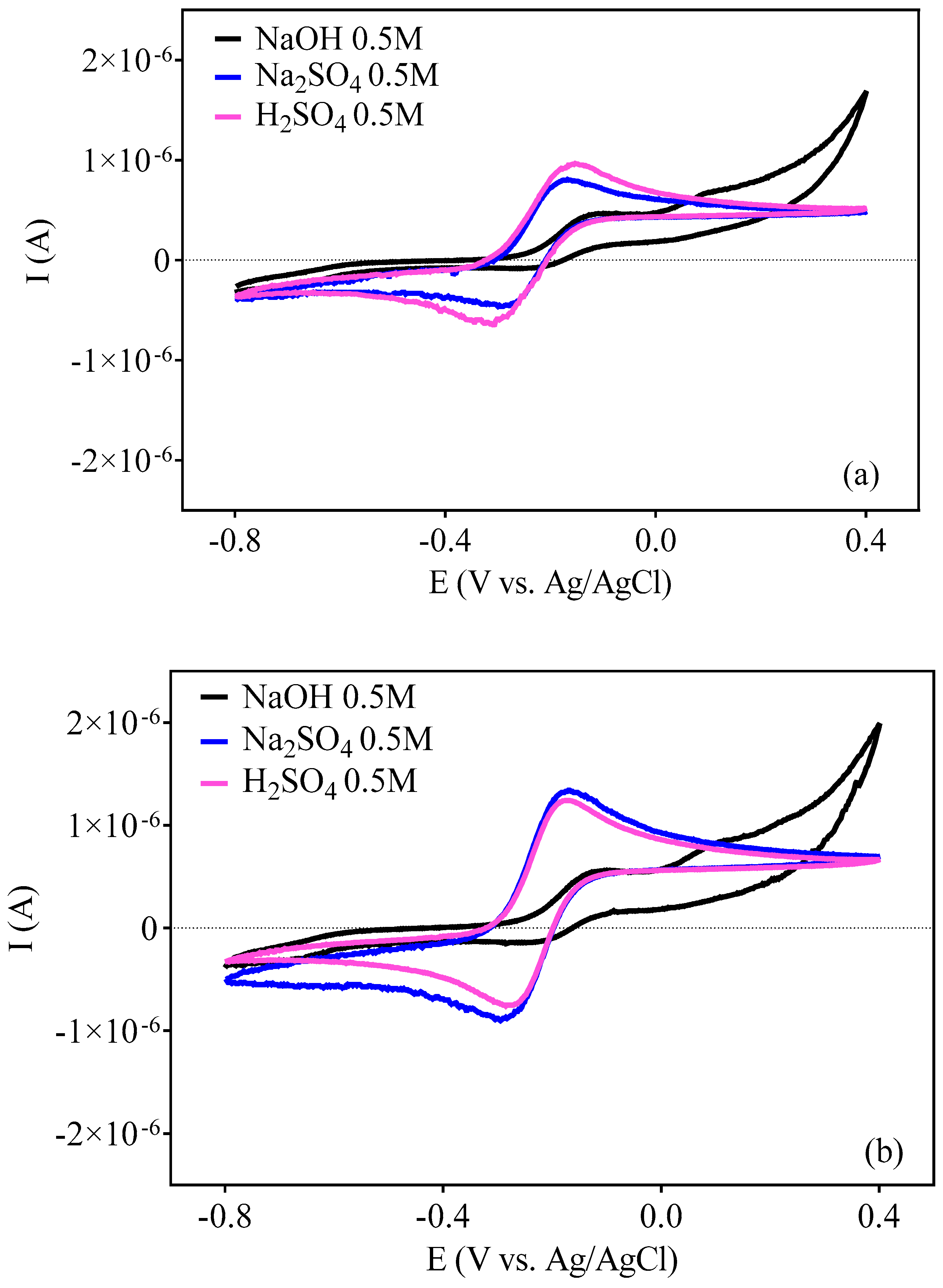
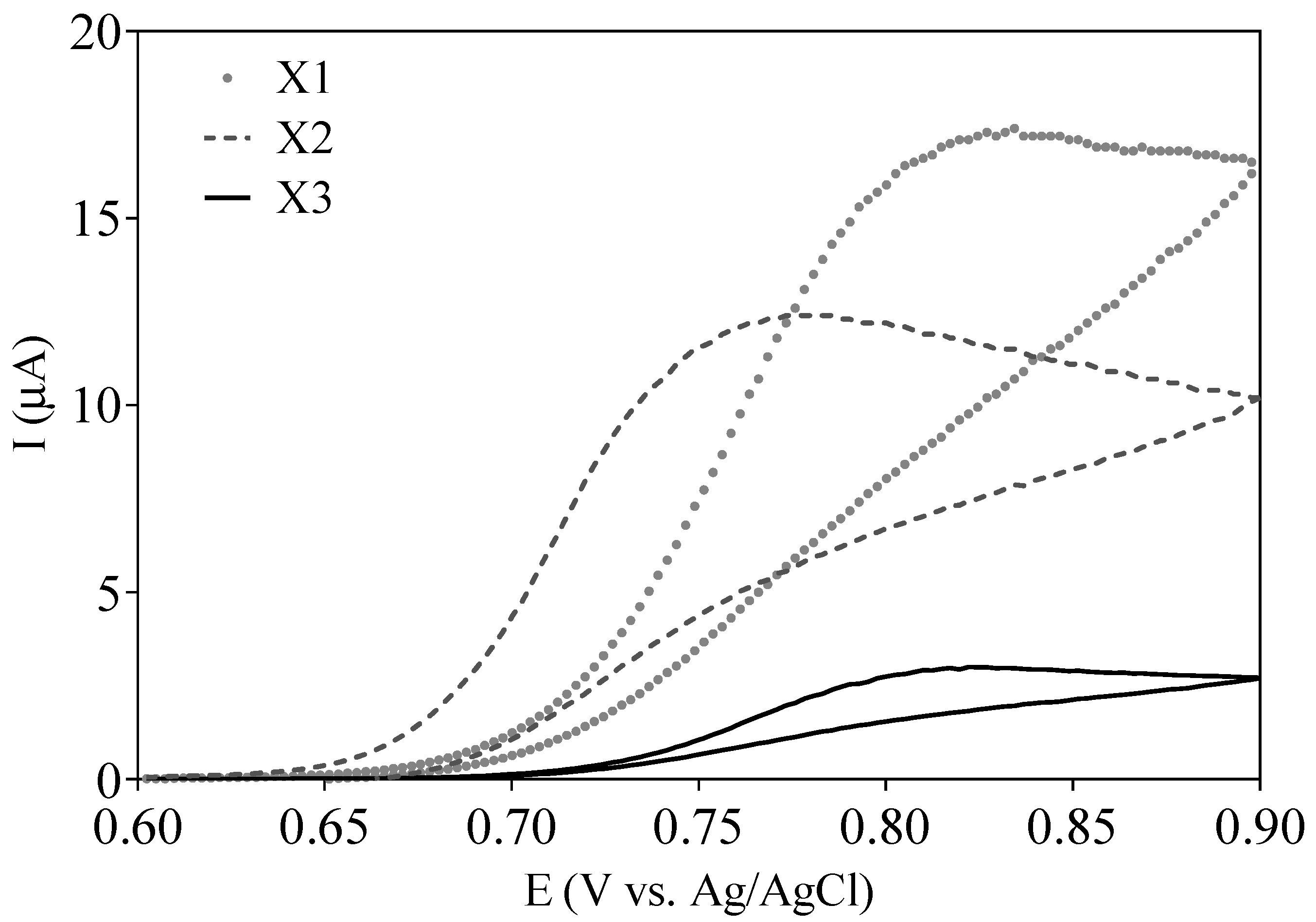

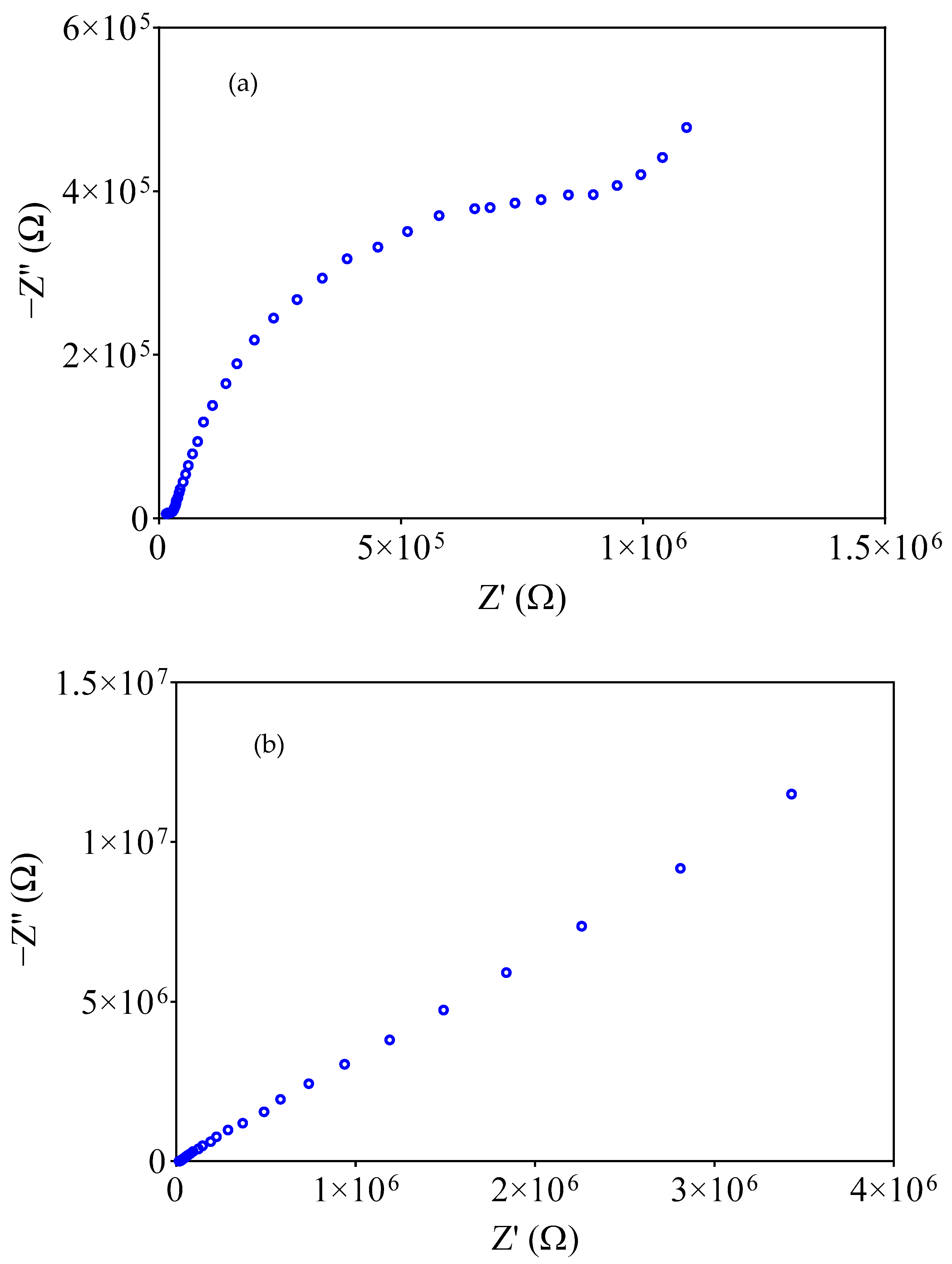
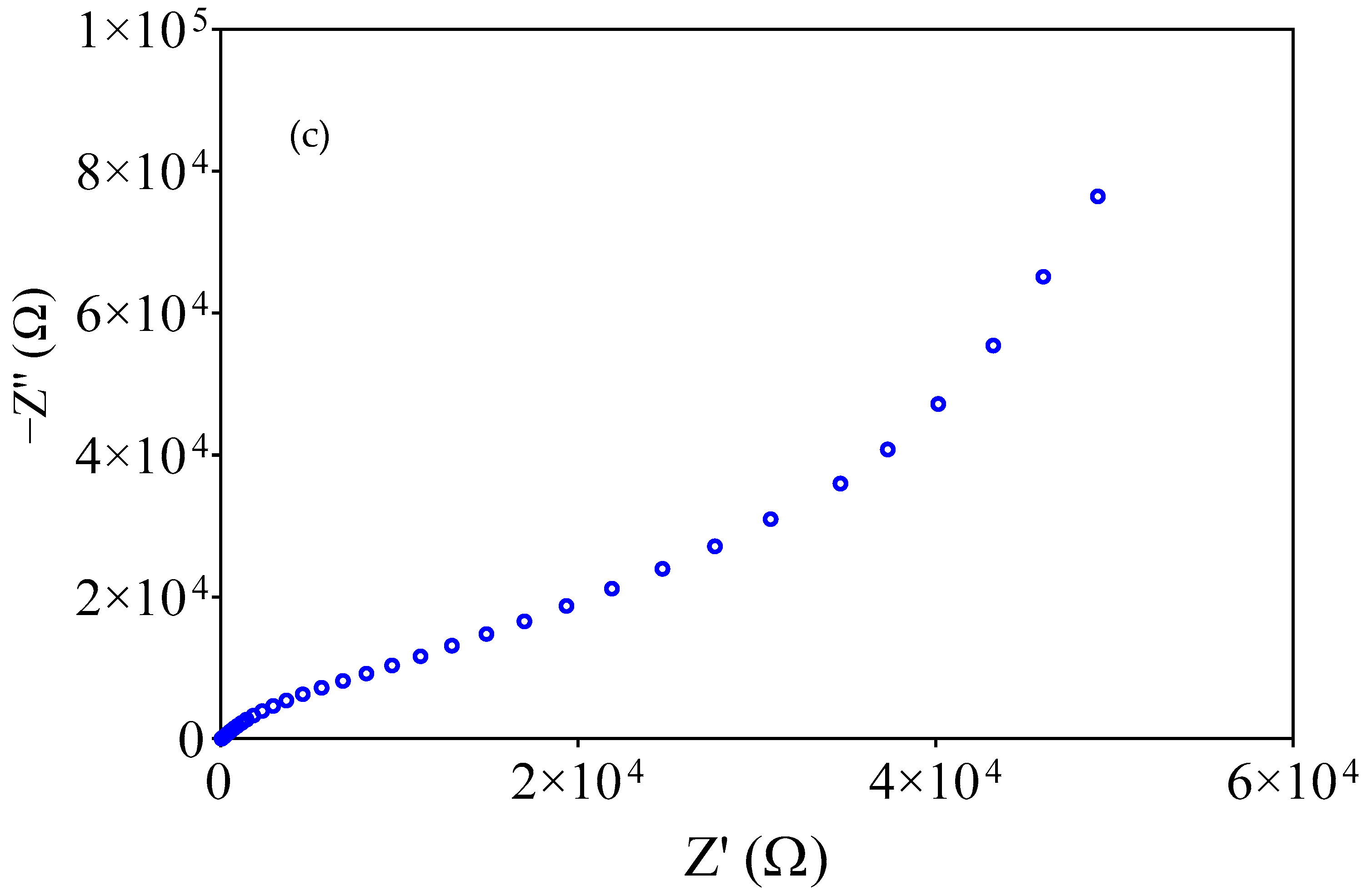

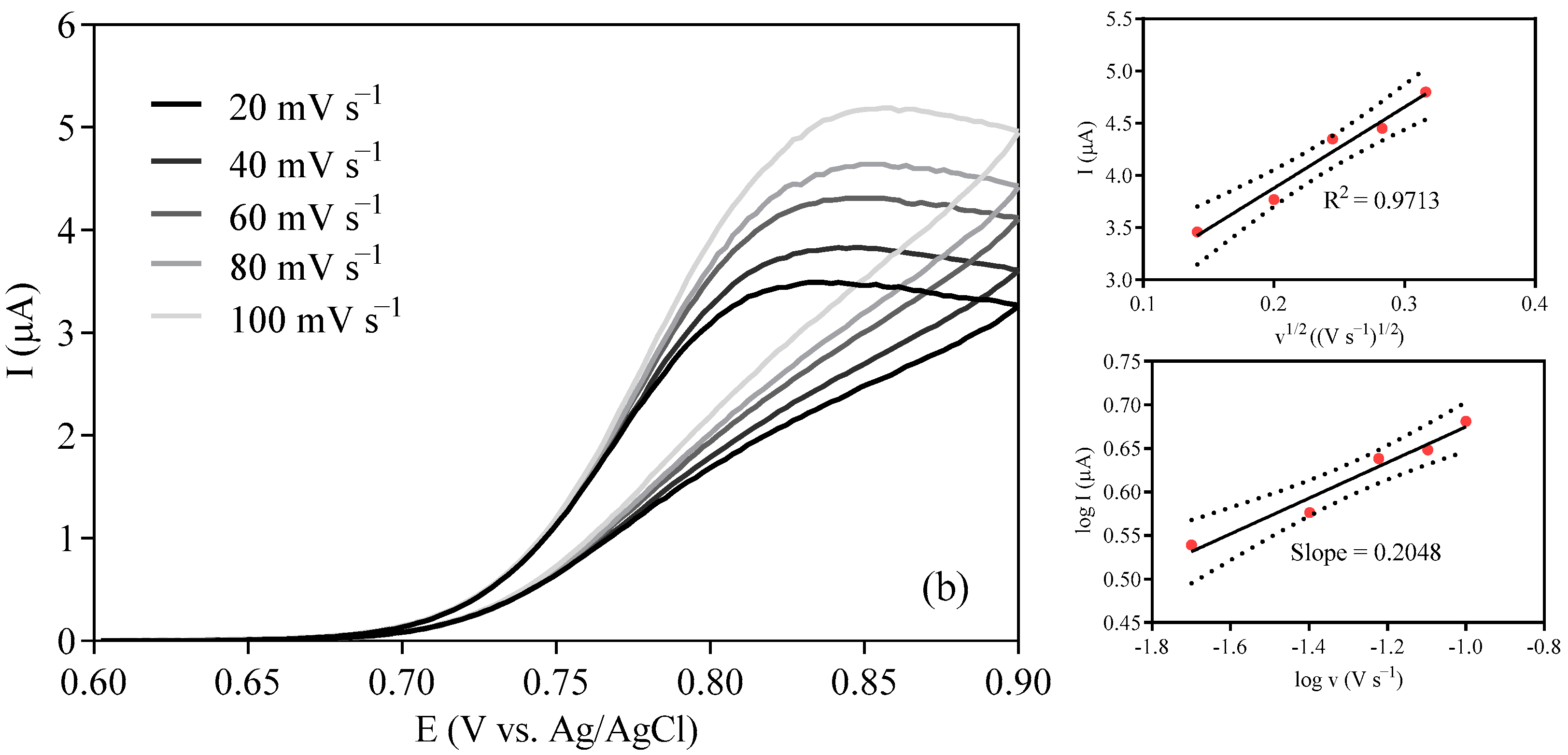
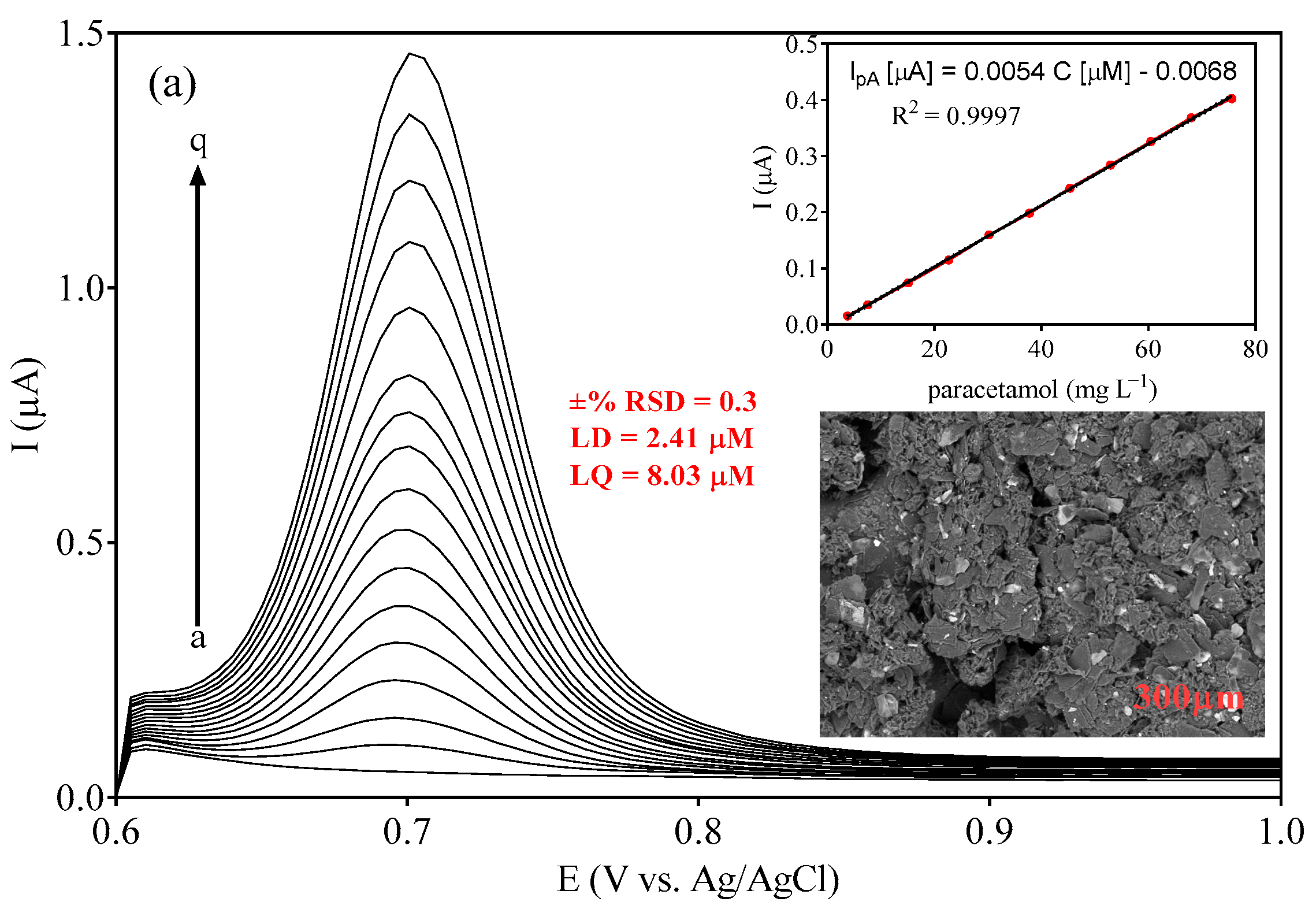
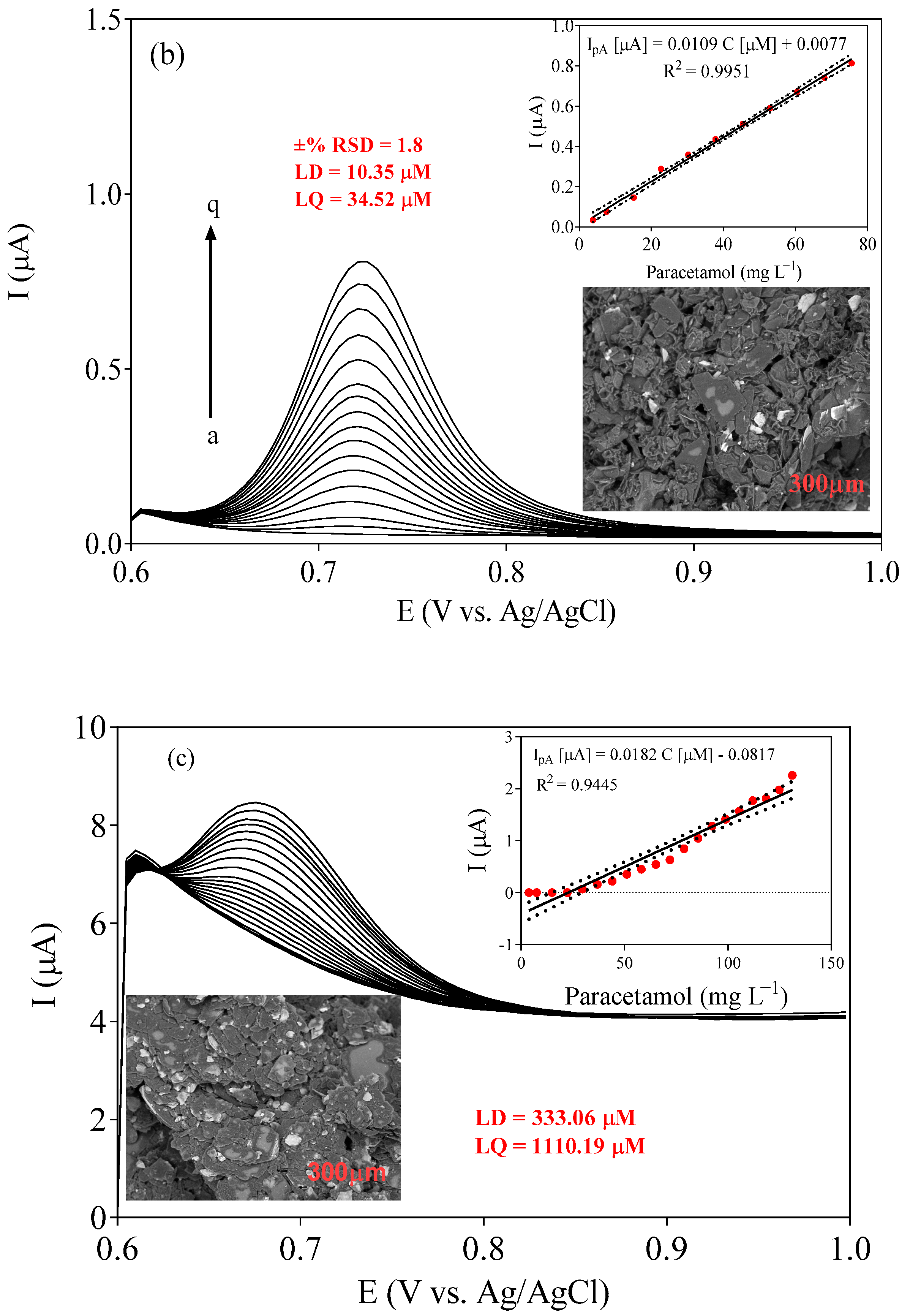
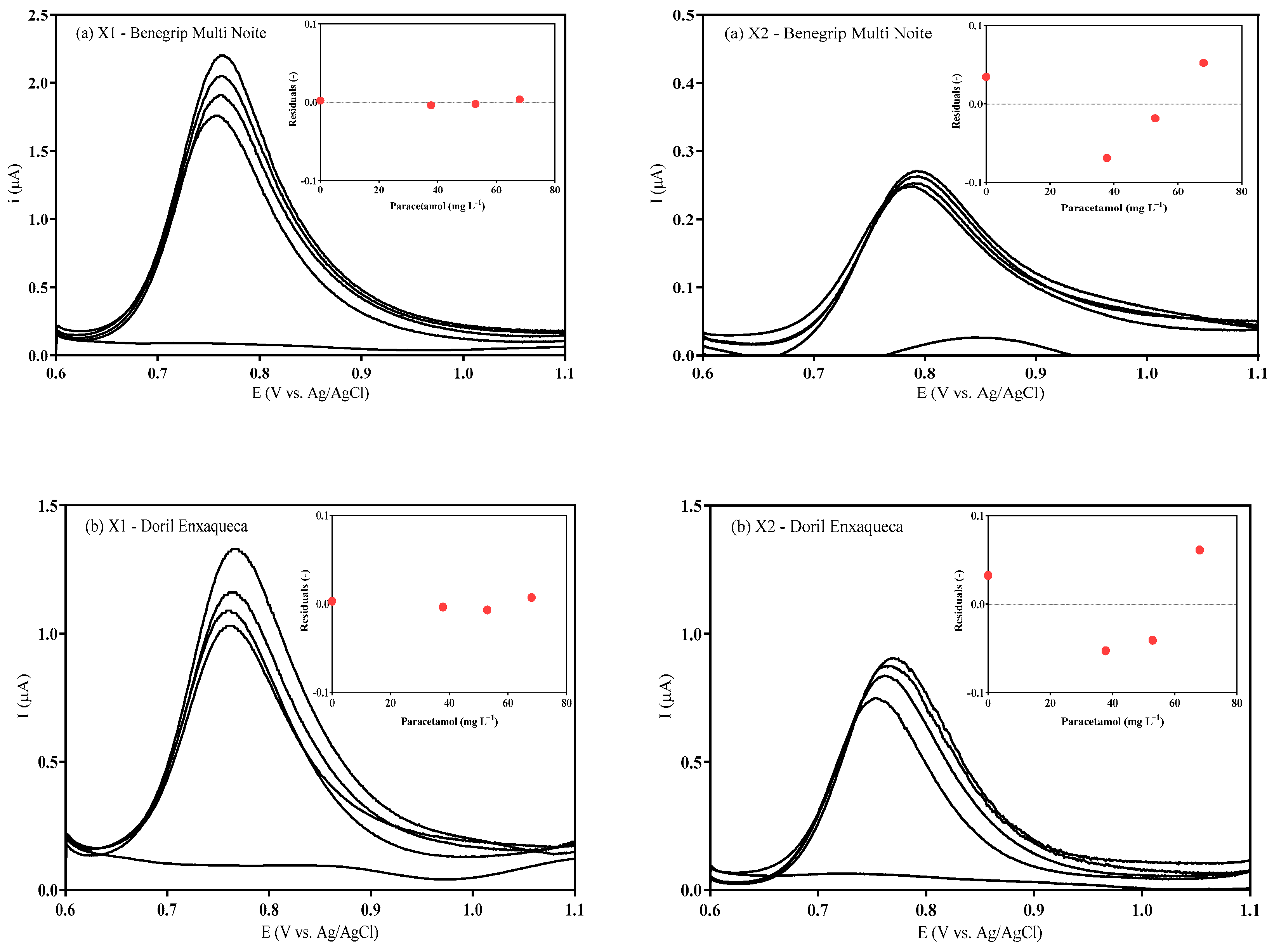
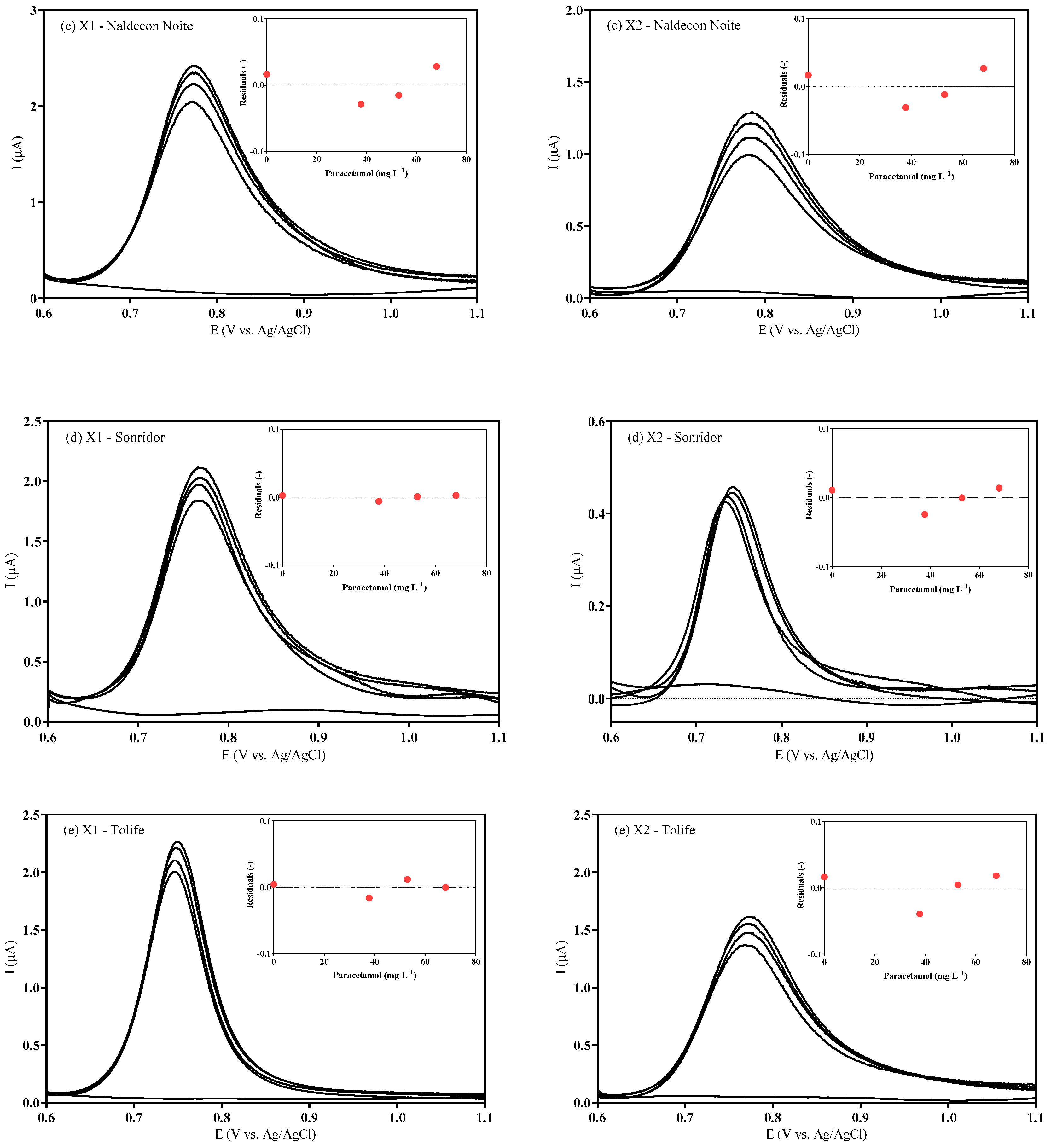
| Electrode | Method | Linear Range (µM) | Detection Limit (µM) | Reference |
|---|---|---|---|---|
| C60 | DPV | 50–1500 | 50 | [38] |
| CDA/Au-Ag NP | DPV | 10–100 | 2.6 | [39] |
| MWCNT/TiO2 | CV | 10–120 | 11.77 | [40] |
| SPE/PEDOT | DPV | 4–400 | 3.7 | [41] |
| Au/Pani/cMWCNT/Bas/GA | DPV | 5–630 | 2.9 | [42] |
| GI/GCE | DPV | 10–500 | 2.7 | [43] |
| NC-GPE | DPV | 50–400 | 3.71 | [44] |
| MWCNT-polymer/GCE | DPV | 5–1000 | 3.5 | [45] |
| NiCu-CAT/GCE | DPV | 5–190 | 5 | [46] |
| DMBQ-MCNTPE | DPV | 5–500 | 1 | [47] |
| GCE-M221-Fe3O4 | DPV | 50–2000 | 16 | [48] |
| AGCE | DPV | 0.1–100 | 0.72 | [49] |
| GO/GCE | DPV | 0.1–430 | 0.021 | [50] |
| AuNCs/BC | DPV | 0.003–50 | 1 | [51] |
| SCB-activatedbiochar/GCE | DPV | 5–950 | 2.5 | [52] |
| RC-modified carbon paste (X1) | DPV | 25–1000 | 2.4 | This work |
| Medicine | Paracetamol (mg) | |||
|---|---|---|---|---|
| a | b * | c * | d * | |
| Benegrip Multi Noite | 800 | 669.17 ± 3.86 | 945.70 ± 5.46 | 760.92 ± 4.39 |
| Doril Enxaqueca | 250 | 279.35 ± 1.61 | 348.60 ± 2.01 | 321.20 ± 1.85 |
| Naldecon Noite | 800 | 775.67 ± 4.48 | 917.66 ± 5.30 | 794.05 ± 4.58 |
| Sonridor | 500 | 436.50 ± 2.52 | 626.10 ± 3.61 | 578.11 ± 3.34 |
| Tolife | 1000 | 965.03 ± 5.57 | 1099.90 ± 6.35 | 948.78 ± 5.48 |
Disclaimer/Publisher’s Note: The statements, opinions and data contained in all publications are solely those of the individual author(s) and contributor(s) and not of MDPI and/or the editor(s). MDPI and/or the editor(s) disclaim responsibility for any injury to people or property resulting from any ideas, methods, instructions or products referred to in the content. |
© 2024 by the authors. Licensee MDPI, Basel, Switzerland. This article is an open access article distributed under the terms and conditions of the Creative Commons Attribution (CC BY) license (https://creativecommons.org/licenses/by/4.0/).
Share and Cite
Monteiro, M.K.S.; Monteiro, M.M.S.; Henrique, J.M.M.; Martínez-Huitle, C.A.; Ferro, S.; dos Santos, E.V. Voltammetric Investigation of Paracetamol Detection in Acidic Conditions by Using Cork-Modified Carbon Paste Electrodes. Chemosensors 2024, 12, 183. https://doi.org/10.3390/chemosensors12090183
Monteiro MKS, Monteiro MMS, Henrique JMM, Martínez-Huitle CA, Ferro S, dos Santos EV. Voltammetric Investigation of Paracetamol Detection in Acidic Conditions by Using Cork-Modified Carbon Paste Electrodes. Chemosensors. 2024; 12(9):183. https://doi.org/10.3390/chemosensors12090183
Chicago/Turabian StyleMonteiro, Mayra K. S., Mayara M. S. Monteiro, João M. M. Henrique, Carlos A. Martínez-Huitle, Sergio Ferro, and Elisama Vieira dos Santos. 2024. "Voltammetric Investigation of Paracetamol Detection in Acidic Conditions by Using Cork-Modified Carbon Paste Electrodes" Chemosensors 12, no. 9: 183. https://doi.org/10.3390/chemosensors12090183
APA StyleMonteiro, M. K. S., Monteiro, M. M. S., Henrique, J. M. M., Martínez-Huitle, C. A., Ferro, S., & dos Santos, E. V. (2024). Voltammetric Investigation of Paracetamol Detection in Acidic Conditions by Using Cork-Modified Carbon Paste Electrodes. Chemosensors, 12(9), 183. https://doi.org/10.3390/chemosensors12090183








